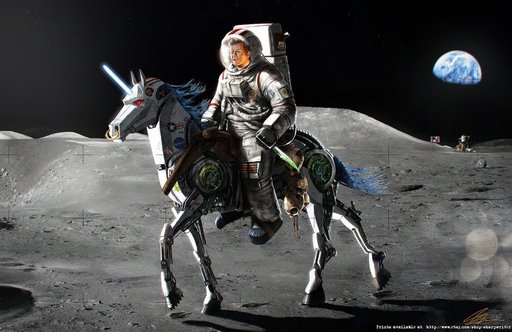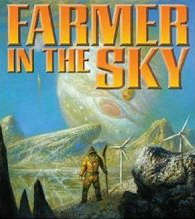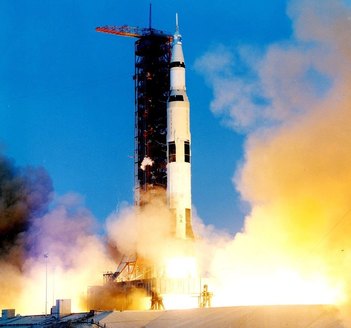It Takes a Global Village to Raise a Starship
Science Fiction doesn't just prefer to tell familiar stories about star travel, it prefers wish-fulfillment stories where star travel is thousands or millions of times easier than it certainly will be. The real story, not yet attempted, is that it will be a truly gigantic, multi-generational project for a whole globe working together.
 I've written that Science Fiction has a bad habit of just hauling out old, familiar stories and putting some outer-space trappings around them, rather than working out what stories would be compelled by the very different circumstances of space travel. TV starship crews, in particular, all hew to a British Navy structure based around the need for chain-of-command during battles of attrition.
I've written that Science Fiction has a bad habit of just hauling out old, familiar stories and putting some outer-space trappings around them, rather than working out what stories would be compelled by the very different circumstances of space travel. TV starship crews, in particular, all hew to a British Navy structure based around the need for chain-of-command during battles of attrition.
There's a much larger sense of SF's love of past stories, however: the entire galactic future is imagined as just a replay of the Age of European Colonization. Intrepid expeditions of a ship or six find colonizable planet after planet, and plant growing colonies that eventually fill them up, and in turn become generators of colonists, themselves.
That future requires not just the possibility of Faster-Than-Light drive (FTL), but it has to be cheap. Ever notice that about the many kinds of FTL drive in SF, from hyperspace to stargates to JumpDrives? They're cheap. That's because if there was an FTL drive, but it took a tonne of uranium to move a gram of payload to Sirius, then you also wouldn't be able to tell the stories writers like, of a small group of adventurers or settlers. A million tonnes of uranium mined and burned in reactors and expended, per settler, isn't going to make any of Mr. Heinlein's Conestoga Wagons on distant planets happen, even if a mere $200 billion per Conestoga would get them there in a week flat.
 Let's set aside, for a moment, just how rare your "Class M" planet, those Star Trek planets that all resembled parts of southern California, would be. The movie "Interstellar" hinted how uncommon it is for the right temperature and chemistry to show up at random. Let's review first, how crazy it is to talk casually of star travel at all.
Let's set aside, for a moment, just how rare your "Class M" planet, those Star Trek planets that all resembled parts of southern California, would be. The movie "Interstellar" hinted how uncommon it is for the right temperature and chemistry to show up at random. Let's review first, how crazy it is to talk casually of star travel at all.
Space, as Douglas Adams noted, is really, really big. Space is so big we cannot imagine it. And we certainly cannot conquer it as we are. It's just too big. The speed of light is not like the speed of sound; it's not an engineering problem. It's a statement of "what the shape of space is." It's the constant that relates space to time in our space-time universe. Hoping that some super-genius will figure out a way to exceed the speed of light is like hoping he'll figure out how to make pi equal to three - or how to make a triangle with four sides. There are now SF writers, like Alastair Reynolds (a real scientist), who just don't write FTL stories, calling them "fantasy".
So, take a moment to absorb the full meanings of that, because there are a few. The first is that star travel stories will play out over what for humans is Deep Time: multiple generations, with no one person seeing the beginning and end of the story. The second is that any star travel story that does not take centuries will involve the handling of truly stupendous amounts of energy.
Never mind shipping people around, that takes a lot of spacecraft. How about a star probe of 100 tonnes? Our Cassini probe was just over 2 tonnes, dry, nearly 6 tonnes with all the fuel it gradually used up, moving around Saturn. Since a star probe would have to fly around a whole solar system, and you'd want to send multiple soft-landers if possible, I'm going to go with the 100-tonne order-of-magnitude.
So for a story that takes mere decades, not centuries, we have to get it up to about 10% of the speed of light. Hand-wave away how for the moment; just roughly, how much energy does that star-drive have to put into it? Turns out that at 10% of the speed of light, 100 tonnes has as much kinetic energy as you could generate with a 1 gigawatt (i.e. city-powering) power plant in 1400 years.
 Our most powerful engine in history, the Saturn V, expelled its exhaust at a nearly-constant 44 gigawatts, more energy flow than all the power plants in the United States when Apollos were launched. One would still have to run for 32 continuous years, somehow teleporting all of its power output into adding kinetic energy to the probe the whole time, to give it that 45 exajoules (45 million million million - no, really) the probe would have, moving at 30 million metres per second.
Our most powerful engine in history, the Saturn V, expelled its exhaust at a nearly-constant 44 gigawatts, more energy flow than all the power plants in the United States when Apollos were launched. One would still have to run for 32 continuous years, somehow teleporting all of its power output into adding kinetic energy to the probe the whole time, to give it that 45 exajoules (45 million million million - no, really) the probe would have, moving at 30 million metres per second.
When I talk about "kinetic energy", I'm skipping over the problem of an efficient space drive and assuming perfect efficiency. When a rocket burns chemical or nuclear fuel and creates energy, it definitely does not all appear as kinetic energy of the vehicle: most of it goes into the exhaust, which races away from the vehicle with kinetic energy of its own. Fuel does two things in a rocket drive: it burns, creating chemical energy, but it also forms the "reaction mass" that goes the other way from the rocket. SF writer Larry Niven wished for the "reactionless drive" where you just supply power to a flat plate that somehow emits something (massless) that causes your ship to go the opposite direction. Presumably if you supply a million kilowatt-hours to the Niven Reactionless Drive, your ship acquires a million kWh of kinetic energy; that would be perfect.
But even if you could do that, you'd still need some way to come up with 45 exajoules. Our cheapest energy at the moment clocks in around a nickel per kilowatt-hour; at those prices, the probe needs to somehow create or be sent 625 billion dollars worth of energy. If the drive is not Mr. Niven's, you likely need many trillions of dollars worth.
At this point, our probe needs just 42 years to get to Alpha Centauri A, the nearest star that is a type G like our Sun. It then does not get to drop off any landers or even have a good look, because it will pass through the system, from as far as Saturn is from our Sun to as far again away, in just 12 hours. Unless, of course, you expend as much star-drive energy all over again to slow it down.
So, that's why SF writers need, absolutely need, for star travel to be many times faster, but above all thousands of times cheaper in energy, if they want their interstellar tale to be anything but the tale of a whole planet spending billions like they were water, for generations on end.
 The novel I picked on for its shameless genesis of designing the science around the desire to crew it with latter-day British Navy, Larry Niven and Jerry Pournelle's "The Mote in God's Eye", does have such a project: but it's the hapless aliens who manage it. Their slower-than-light ship takes generations to arrive, after the whole planetary civilization has conspired for over a century to run a massive laser system the size of cities, which powers a light-sail across whole light-years, a sail nearly the diameter of Earth's moon...all to send one small probe. We see the very end of that project, because that's the only interesting part for adventurers; the first 99.99% of it was just a huge industrial bureaucracy at work.
The novel I picked on for its shameless genesis of designing the science around the desire to crew it with latter-day British Navy, Larry Niven and Jerry Pournelle's "The Mote in God's Eye", does have such a project: but it's the hapless aliens who manage it. Their slower-than-light ship takes generations to arrive, after the whole planetary civilization has conspired for over a century to run a massive laser system the size of cities, which powers a light-sail across whole light-years, a sail nearly the diameter of Earth's moon...all to send one small probe. We see the very end of that project, because that's the only interesting part for adventurers; the first 99.99% of it was just a huge industrial bureaucracy at work.
That part of the novel followed the work of scientist, and occasional SF author, Dr. Robert L. Forward, who put out many science-fact articles describing star-travel approaches that could work in our universe: the common feature is that they were all gigantic expenditures of energy, unthinkably expensive for today's humanity, requiring, frankly, a whole different, far better, civilization than ours.
Kurt Vonnegut wrote that after his first book, "Player Piano", critics "stuck him in the SF drawer; I've been a soreheaded occupant of that drawer ever since, mainly because critics often mistake it for a urinal." Vonnegut thought most SF shallow then, because it showed young protagonists discovering a space drive, going off to distant planets and having great heroic adventures - "exactly as they already were: young, pimples, virginity, everything". Events so gigantic should challenge and change people; the character at the end of the story should be a different character.
As with Vonnegut's 1950's adventuring teens, the challenges of space should require a hugely transformed human society to handle them. Instead of just postulating a magic ignore-the-rules-for-free card so that they can write a story of very familiar structure drawn on past stories, authors would have to imagine a social organization that can handle a challenge orders of magnitude larger than ever faced by humans before.
Real space exploration is not going to be done by even the largest corporations or nation-states in search of profit, because no profit will appear for centuries, if ever. Interstellar exploration is almost certainly going to happen only because an entire industrialized globe of wealthy humans wants to know What's Out There - and everyone chips in on it.
 The best piece of SF to recently address this projection was Charlie Stross's Neptune's Brood (2013). Charlie saw us going to the stars only after we accepted that we'd have to be genetically engineered into completely different bodies that could stand the environmental extremes and radiation; that little progress would happen until people could live for hundreds of years to see the payback from interstellar projects; and that the whole economy would have to be warped around the concept of multi-century investments.
The best piece of SF to recently address this projection was Charlie Stross's Neptune's Brood (2013). Charlie saw us going to the stars only after we accepted that we'd have to be genetically engineered into completely different bodies that could stand the environmental extremes and radiation; that little progress would happen until people could live for hundreds of years to see the payback from interstellar projects; and that the whole economy would have to be warped around the concept of multi-century investments.
Stross invented the "Slow Dollar," a separate currency where the smallest unit was a million normal dollars and you couldn't "cash out" even one Slow Dollar without great warning time or ruinous discount. Vonnegut might have approved: no teenage society with acne (ours, that is) is going to be able to conquer the stars.
Our little species, with its adorably tiny $25 trillion/year economic output is just not big enough for the size of the problem. The society that can start and finish interstellar exploration projects will have to be bigger - and far richer - than our global society today. It will need to leverage those riches with a much longer time-scale in its visions, both because physics decrees the problem-size to be large in the time dimension, and to allow more resources to be expended. Suppose building the solar-sail, or the gigatonne of deuterium fusion fuel for the solution, takes 150 years of patient construction? Our current society could not even imagine doing that, just so that great-grandchildren of the founders could see Launch Day.
We do appear to be getting there. Our wars have shrunk. Nation-states have grown in size and stability with democratization. Because of trade pacts, shared ventures, and the UN, some even dream of "One World," though "Fuzzy-Minded One-Worlder" has been a catchphrase for "nutball" for at least a century.
We will need that "One World" to conquer space; if not a world government, then a world-wide shared agreement to large projects. It'll take 10 billion people, all averaging $100,000/year in economic output by today's measures, and all willing to chip in a couple of thousand per year, for a $20 trillion space budget.That's the kind of resources needed for space elevators and interstellar launches. That's just how big space is.
Science Fiction has spent a whole century projecting forward the curve that says one human has been able to control more and more power over a short time, going from horse, to Model T, to biplanes, to supersonic jets. Stories then assume that this trend will just go on exponentially, giving one human another thousand-fold increase in the energies at their sole command, until they can go rocketing around the spaceways. SF has proven miserable at imagining a future where 1 billion decide to pitch in to build a Mars base; and 10 billion must contribute for 10 peaceful generations to send one small interstellar probe.
That mind-bending thought - humanity civilizing and staying that way without any war, much less laser-blasting nuclear space wars - has proven too difficult for our SF writers to wrap their tiny brains around; they'd rather imagine FTL. Or four-sided triangles. Anything but civilization.
Reagan once dreamed aloud to Gorbechev one of the really classic SF tropes: that an alien landing would force all the squabbling nation-states of humanity to unite. How pathetic, frankly, that the best scenario that he could imagine was a humanity only united by external threat. What about a more optimistic (and mature) story of human triumph: that we united because of enlightened self-interest and external opportunity, because only a whole intelligent species working together and not warring for centuries on end, is able to challenge the stars?
Main Page and Index
Text is COPYRIGHT, Roy Brander, 2017. All graphics are available Internet grabs that link to their source, and will be taken down upon request, to "roy.brander" at Google's mail system.
 I've written that Science Fiction has a bad habit of just hauling out old, familiar stories and putting some outer-space trappings around them, rather than working out what stories would be compelled by the very different circumstances of space travel. TV starship crews, in particular, all hew to a British Navy structure based around the need for chain-of-command during battles of attrition.
I've written that Science Fiction has a bad habit of just hauling out old, familiar stories and putting some outer-space trappings around them, rather than working out what stories would be compelled by the very different circumstances of space travel. TV starship crews, in particular, all hew to a British Navy structure based around the need for chain-of-command during battles of attrition.



